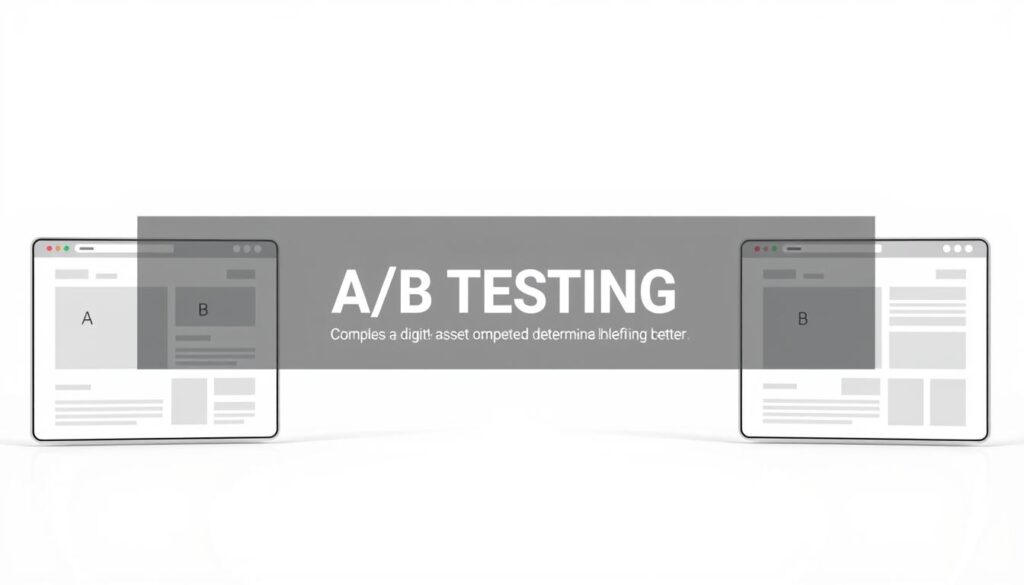A/B testing is a key marketing tool that boosts your conversion rates. It compares two versions of a webpage, email, or ad to see which one works best. This method, also known as split testing, helps you make choices based on data, not guesses.
In today’s digital world, A/B testing is vital for understanding what users like. Big names like Google and Amazon use it to enhance user experiences and increase sales.
Table of Contents
Key Takeaways
- A/B testing helps maximise conversion rate optimisation.
- Data-driven decision making allows for targeted marketing strategies.
- Split testing is essential for uncovering user preferences.
- Digital marketing experiments can lead to better user experiences.
- Renowned brands successfully use A/B testing for performance improvements.
Introduction to A/B Testing
A/B testing is a key tool in marketing analytics. It lets you compare two versions of the same thing. This helps find out which one works better for users and sales.
This method started in the early 20th century in farming and medical trials. Now, it’s a big part of digital marketing.
Using A/B testing in your marketing can show what customers like. You can try out different headlines, images, or calls to action. This helps brands make choices based on data.
It’s key for boosting sales. It helps businesses get better at attracting and keeping customers.
What is A/B Testing?
A/B testing, also known as split testing, is a key part of digital marketing. It involves making two versions of a marketing asset to see which one works best. By randomly choosing who sees each version, you can compare how well they do.
The definition of A/B testing is about making smart choices without guessing. It helps you look closely at important numbers like how many people convert or click. Knowing these numbers is key to making your marketing better.
Testing works like a science experiment, where you change one thing at a time to see how it affects people. You can test different things like how a page looks, what colours you use, or how buttons work. This helps you find out what works best.
By using what you learn from A/B tests, you can make your marketing more effective. It helps you understand what parts of your content are most successful. This knowledge helps you improve your marketing for the future.
The Importance of A/B Testing in Digital Marketing
A/B testing is key to bettering digital marketing. It compares two content versions to see which one works best. This helps businesses boost their conversion rates.
It lets marketers make choices based on data, not just guesses. This way, every campaign is backed by solid evidence.
In today’s fast-changing digital world, A/B testing is more important than ever. It helps companies make smart changes to keep users happy and loyal. With more shopping happening on mobile apps, knowing what works best is vital.
For example, comparing mobile and desktop versions can reveal important insights. These insights can lead to even better marketing strategies.
Using A/B testing means using resources wisely, getting the most out of every dollar. It’s a scientific way to improve marketing plans. For more on why A/B testing matters, check out this article.
Benefits of A/B Testing in Marketing
A/B testing brings big wins to your marketing plans. It helps you find out what works best with your customers. This way, you can make your marketing better, get more people involved, and boost sales.
Improved Content Engagement
A/B testing is great for making your content more engaging. You can try out different headlines and images to see what people like. For example, BuzzFeed uses it to make their headlines more appealing.
This means more people click on your content. It’s a smart way to grab your audience’s attention.
Enhanced User Experience
Improving how people use your website is key. A/B testing lets you test different parts of your site. This makes it easier for visitors to find what they need.
By making small changes, you can keep people on your site longer. This makes for a better experience for everyone.
Increased Conversion Rates
A/B testing really helps with getting more people to take action. By tweaking things like call-to-action buttons, you can see big improvements. Even small changes, like button colours, can make a big difference.
This shows how important A/B testing is for your marketing success. It helps you get the most out of your efforts.
A/B Testing in Marketing: Key Metrics to Track
Effective A/B testing needs the right metrics to guide your decisions. Knowing these metrics helps you improve your marketing strategies. Key metrics include click-through rates and bounce rates, which show how users interact with your content.
Click-Through Rates
Click-through rates (CTR) are key to measuring your marketing’s success. They show how many users click on your links or calls to action. By testing different headlines and calls to action, you can boost user engagement.
Bounce Rates
Bounce rate analysis shows how many visitors leave after seeing just one page. A high bounce rate means your content might not be engaging. By testing your web design and content, you can lower bounce rates and improve your site.
| Metric | Definition | Importance |
|---|---|---|
| Click-Through Rate (CTR) | Percentage of clicks on a link relative to total visitors | Indicates effectiveness of calls to action and content relevance |
| Bounce Rate | Percentage of visitors who leave after viewing one page | Reveals user engagement and content appeal |
Implementing A/B Testing in Your Marketing Strategy
To start A/B testing, you need clear goals that match your marketing plans. It’s important to pick a main metric to work on, like click-through rates or conversion rates. After setting your goal, choosing the right variables is key to getting good results.
The tools you use for A/B testing are very important. Platforms like Optimizely are made for this purpose. They let you test different versions of your pages or ads and watch how users react.
Good A/B testing needs you to keep looking at the results. By analysing what happens in your tests, you can make your marketing better. With each test, you learn more about what works and can improve your marketing even more.
Types of A/B Testing Approaches
Marketers can gain a lot by understanding different A/B testing types. There are two main types: simple A/B testing and multivariate testing. Each type is suited for different needs and goals.
Simple A/B Testing
Simple A/B testing compares two versions of one thing. It’s easy to set up and understand. You can see how changes to headlines or buttons affect users.
It’s great for small campaigns because it’s quick and doesn’t need much. You can make changes fast based on clear data.
Multivariate Testing
Multivariate testing looks at many things at once. It gives deeper insights into how different parts of a page work together. But, it needs a bigger sample size for reliable results.
It’s best for seeing how different elements work together. Knowing when to use each type is key.
Using these A/B testing types well can really improve your marketing. For more info, check out this resource on the different methods.
Common Mistakes in A/B Testing
A/B testing is a key tool for marketers to improve their results. But, many errors can get in the way. One big mistake is testing too many things at once. This can make the data hard to understand and use.
Not having enough people in your test is another error. Without enough participants, the results might not be clear. It’s also important to track all the important metrics, not just the main ones.
Testing for too short a time can also lead to wrong results. A test needs to run long enough to show real user patterns. Also, keeping the test conditions the same is vital. Any changes can mess up your findings.
Knowing these common mistakes can help you improve your A/B tests. This leads to more accurate and useful results.
Case Studies: Successful A/B Testing Examples
A/B testing case studies show how marketing can change. Companies like HubSpot have shown its power. They’ve tested everything from email subjects to landing pages, improving user engagement and sales.
In eCommerce, success stories are common. Big retailers have used A/B testing to improve their sites. For example, a fashion store changed their CTA button colour and saw a 15% rise in sales. This shows how A/B testing can boost revenue.
A/B testing isn’t just for marketing. Social media platforms use it too. They test different ad formats to see what works best. This shows how A/B testing is key in today’s marketing world.
Conclusion
A/B testing is key for marketers wanting to boost conversion rates and improve user engagement. It involves a systematic approach to testing and analysing data. This helps you understand what works best for your audience.
The future of A/B testing looks bright with new data analytics and AI tools. These advancements will help you make better decisions, leading to more successful marketing. By using A/B testing, you can always improve and stay competitive.
Getting a solid A/B testing summary is vital for better marketing. With a focus on testing, you meet customer needs and help your business grow. It’s a way to ensure your marketing is effective and successful.









